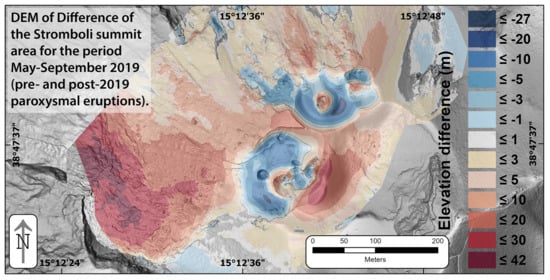Unoccupied Aircraft Systems (UASs) Reveal the Morphological Changes at Stromboli Volcano (Italy) before, between, and after the 3 July and 28 August 2019 Paroxysmal Eruptions
Abstract
:1. Introduction
2. Approaches and Methods
2.1. Volcanic Activity and the 2019 Paroxysmal Eruptions
2.2. Data Collection and Processing
2.3. DEMs of Difference and Volume Calculations
3. Results
3.1. Chronological Evolution of the Crater Area Morphology
3.2. Volume Change Estimation
3.3. Topographic Variations
4. Discussion and Conclusions
4.1. UAS Volcanology: Limitations and Advantages
4.2. Processes Controlling the Morphology Changes
4.2.1. Constructive Processes
4.2.2. Destructive Processes
4.3. Comparison of 2019 and Previous Effusive Eruptions
4.4. Conclusive Remarks
Supplementary Materials
Author Contributions
Funding
Data Availability Statement
Acknowledgments
Conflicts of Interest
References
- Carr, B.B.; Clarke, A.; Arrowsmith, J.R.; Vanderkluysen, L.; Dhanu, B.E. The emplacement of the active lava flow at Sinabung Volcano, Sumatra, Indonesia, documented by Structure-from-Motion photogrammetry. J. Volcanol. Geotherm. Res. 2019, 382, 164–172. [Google Scholar] [CrossRef]
- Favalli, M.; Fornaciai, A.; Mazzarini, F.; Harris, A.; Neri, M.; Behncke, B.; Pareschi, M.T.; Tarquini, S.; Boschi, E. Evolution of an active lava flow field using a multitemporal LIDAR acquisition. J. Geophys. Res. Space Phys. 2010, 115, 11203. [Google Scholar] [CrossRef] [Green Version]
- James, M.R.; Pinkerton, H.; Applegarth, L.J. Detecting the development of active lava flow fields with a very-long-range terrestrial laser scanner and thermal imagery. Geophys. Res. Lett. 2009, 36, 22305. [Google Scholar] [CrossRef]
- James, M.; Robson, S. Sequential digital elevation models of active lava flows from ground-based stereo time-lapse imagery. ISPRS J. Photogramm. Remote Sens. 2014, 97, 160–170. [Google Scholar] [CrossRef]
- Thiele, S.; Varley, N.; James, M. Thermal photogrammetric imaging: A new technique for monitoring dome eruptions. J. Volcanol. Geotherm. Res. 2017, 337, 140–145. [Google Scholar] [CrossRef] [Green Version]
- Pallister, J.; Wessels, R.; Griswold, J.; McCausland, W.; Kartadinata, N.; Gunawan, H.; Budianto, A.; Primulyana, S. Monitoring, forecasting collapse events, and mapping pyroclastic deposits at Sinabung volcano with satellite imagery. J. Volcanol. Geotherm. Res. 2019, 382, 149–163. [Google Scholar] [CrossRef]
- Bisson, M.; Spinetti, C.; Andronico, D.; Palaseanu-Lovejoy, M.; Buongiorno, M.F.; Alexandrov, O.; Cecere, T. Ten years of volcanic activity at Mt Etna: High-resolution mapping and accurate quantification of the morphological changes by Pleiades and Lidar data. Int. J. Appl. Earth Obs. Geoinf. 2021, 102, 102369. [Google Scholar] [CrossRef]
- Fornaciai, A.; Andronico, D.; Favalli, M.; Spampinato, L.; Branca, S.; Lodato, L.; Bonforte, A.; Nannipieri, L. The 2004–2005 Mt. Etna Compound Lava Flow Field: A Retrospective Analysis by Combining Remote and Field Methods. J. Geophys. Res. Solid Earth 2021, 126, 020499. [Google Scholar] [CrossRef]
- Di Traglia, F.; De Luca, C.; Manzo, M.; Nolesini, T.; Casagli, N.; Lanari, R.; Casu, F. Joint exploitation of space-borne and ground-based multitemporal InSAR measurements for volcano monitoring: The Stromboli volcano case study. Remote Sens. Environ. 2021, 260, 112441. [Google Scholar] [CrossRef]
- Taddeucci, J.; Scarlato, P.; Del Bello, E.; Spina, L.; Ricci, T.; Gaudin, D.; Tournigand, P.-Y. The dynamics of explosive mafic eruptions: New insights from multiparametric observations. In Forecasting and Planning for Volcanic Hazards, Risks, and Disasters; Elsevier BV: Amsterdam, The Netherlands, 2021; Volume 2, pp. 379–411. [Google Scholar]
- Jordan, B.R. Collecting field data in volcanic landscapes using small UAS (sUAS)/drones. J. Volcanol. Geotherm. Res. 2019, 385, 231–241. [Google Scholar] [CrossRef]
- James, M.R.; Carr, B.; D’Arcy, F.; Diefenbach, A.; Dietterich, H.; Fornaciai, A.; Lev, E.; Liu, E.; Pieri, D.; Rodgers, M.; et al. Volcanological applications of unoccupied aircraft systems (UAS): Developments, strategies, and future challenges. Volcanica 2020, 3, 67–114. [Google Scholar] [CrossRef] [Green Version]
- James, M.; Robson, S. Straightforward reconstruction of 3D surfaces and topography with a camera: Accuracy and geoscience application. J. Geophys. Res. Space Phys. 2012, 117, 03017. [Google Scholar] [CrossRef] [Green Version]
- Nakano, T.; Kamiya, I.; Tobita, M.; Iwahashi, J.; Nakajima, H. Landform monitoring in active volcano by UAV and SfM-MVS technique. ISPRS—Int. Arch. Photogramm. Remote. Sens. Spat. Inf. Sci. 2014, XL-8, 71–75. [Google Scholar] [CrossRef] [Green Version]
- Turner, N.; Houghton, B.; Taddeucci, J.; von der Lieth, J.; Kueppers, U.; Gaudin, D.; Ricci, T.; Kim, K.; Scalato, P. Drone Peers into Open Volcanic Vents. Eos 2017. [Google Scholar] [CrossRef]
- De Beni, E.; Cantarero, M.; Messina, A. UAVs for volcano monitoring: A new approach applied on an active lava flow on Mt. Etna (Italy), during the 27 February–2 March 2017 eruption. J. Volcanol. Geotherm. Res. 2019, 369, 250–262. [Google Scholar] [CrossRef]
- Leggett, T.N.; Befus, K.S.; Kenderes, S. Rhyolite lava emplacement dynamics inferred from surface morphology. J. Volcanol. Geotherm. Res. 2020, 395, 106850. [Google Scholar] [CrossRef]
- Darmawan, H.; Walter, T.R.; Brotopuspito, K.S.; Subandriyo; Nandaka, I.G.M.A. Morphological and structural changes at the Merapi lava dome monitored in 2012–15 using unmanned aerial vehicles (UAVs). J. Volcanol. Geotherm. Res. 2018, 349, 256–267. [Google Scholar] [CrossRef]
- Zorn, E.; Walter, T.R.; Johnson, J.B.; Mania, R. UAS-based tracking of the Santiaguito Lava Dome, Guatemala. Sci. Rep. 2020, 10, 1–13. [Google Scholar] [CrossRef] [PubMed]
- Andaru, R.; Rau, J.-Y.; Syahbana, D.K.; Prayoga, A.S.; Purnamasari, H.D. The use of UAV remote sensing for observing lava dome emplacement and areas of potential lahar hazards: An example from the 2017–2019 eruption crisis at Mount Agung in Bali. J. Volcanol. Geotherm. Res. 2021, 415, 107255. [Google Scholar] [CrossRef]
- Rosi, M.; Pistolesi, M.; Bertagnini, A.; Landi, P.; Pompilio, M.; Di Roberto, A. Chapter 14 Stromboli volcano, Aeolian Islands (Italy): Present eruptive activity and hazards. Geol. Soc. Lond. Mem. 2013, 37, 473–490. [Google Scholar] [CrossRef]
- Schmid, M.; Kueppers, U.; Civico, R.; Ricci, T.; Taddeucci, J.; Dingwell, D.B. Characterising vent and crater shape changes at Stromboli: Implications for risk areas. Volcanica 2021, 4, 87–105. [Google Scholar] [CrossRef]
- Barberi, F.; Rosi, M.; Sodi, A. Volcanic hazard assessment at Stromboli based on review of historical data. Acta Vulcanol. 1993, 3, 173–187. [Google Scholar]
- Andronico, D.; Corsaro, R.; Cristaldi, A.; Polacci, M. Characterizing high energy explosive eruptions at Stromboli volcano using multidisciplinary data: An example from the 9 January 2005 explosion. J. Volcanol. Geotherm. Res. 2008, 176, 541–550. [Google Scholar] [CrossRef]
- Salvatore, V.; Silleni, A.; Corneli, D.; Taddeucci, J.; Palladino, D.M.; Sottili, G.; Bernini, D.; Andronico, D.; Cristaldi, A. Parameterizing multi-vent activity at Stromboli Volcano (Aeolian Islands, Italy). Bull. Volcanol. 2018, 80, 64. [Google Scholar] [CrossRef]
- Bertagnini, A.; Métrich, N.; Francalanci, L.; Landi, P.; Tommasini, S.; Conticelli, S. Volcanology and magma geochemistry of the present-day activity: Constraints on the feeding system. In Learning from Stromboli; Calvari, S.S., Inguaggiato, G., Puglisi, M.R., Rosi, M., Eds.; AGU: Washington, DC, USA, 2008; pp. 19–37. [Google Scholar]
- Métrich, N.; Bertagnini, A.; Pistolesi, M. Paroxysms at Stromboli Volcano (Italy): Source, Genesis and Dynamics. Front. Earth Sci. 2021, 9. [Google Scholar] [CrossRef]
- Andronico, D.; Pistolesi, M. The November 2009 paroxysmal explosions at Stromboli. J. Volcanol. Geotherm. Res. 2010, 196, 120–125. [Google Scholar] [CrossRef]
- Andronico, D.; Taddeucci, J.; Cristaldi, A.; Miraglia, L.; Scarlato, P.; Gaeta, M. The 15 March 2007 paroxysm of Stromboli: Video-image analysis, and textural and compositional features of the erupted deposit. Bull. Volcanol. 2013, 75, 1–19. [Google Scholar] [CrossRef]
- Tibaldi, A.; Corazzato, C.; Apuani, T.; Pasquarè, F.A.; Vezzoli, L.; Calvari, S.; Inguaggiato, S.; Puglisi, G.; Ripepe, M.; Rosi, M. Geological-Structural Framework of Stromboli Volcano, Past Collapses, and the Possible Influence on the Events of the 2002–2003 Crisis. In Large Igneous Provinces; American Geophysical Union (AGU): Washington, DC, USA, 2013; pp. 5–17. [Google Scholar]
- Tibaldi, A. Multiple sector collapses at Stromboli volcano, Italy: How they work. Bull. Volcanol. 2001, 63, 112–125. [Google Scholar] [CrossRef]
- Calvari, S.; Bonaccorso, A.; Madonia, P.; Neri, M.; Liuzzo, M.; Salerno, G.G.; Behncke, B.; Caltabiano, T.; Cristaldi, A.; Giuffrida, G.; et al. Major eruptive style changes induced by structural modifications of a shallow conduit system: The 2007–2012 Stromboli case. Bull. Volcanol. 2014, 76, 1–15. [Google Scholar] [CrossRef]
- INGV (2019). Stromboli, Rep. N° 27/2019. Bollettino Settimanale, 24–30 June 2019. Available online: https://www.ct.ingv.it/index.php/monitoraggio-e-sorveglianza/prodotti-del-monitoraggio/bollettini-settimanali-multidisciplinari/83-bollettino-settimanale-sul-monitoraggio-vulcanico-geochimico-e-sismico-del-vulcano-stromboli-del-02-07-2019/file (accessed on 17 July 2021).
- Andronico, D.; Del Bello, E.; D’Oriano, C.; Landi, P.; Pardini, F.; Scarlato, P.; Vitturi, M.D.M.; Taddeucci, J.; Cristaldi, A.; Ciancitto, F.; et al. Uncovering the eruptive patterns of the 2019 double paroxysm eruption crisis of Stromboli volcano. Nat. Commun. 2021, 12, 4213. [Google Scholar] [CrossRef]
- INGVvulcani. The 3 July 2019 Paroxysm of Stromboli and Its Activity during the Following Days. 2019. Available online: https://ingvvulcani.com/2019/07/15/the-3-july-2019-paroxysm-of-stromboli-and-its-activity-during-the-following-days/ (accessed on 17 July 2021).
- LGS_UNIFI. Esplosione parossistica del vulcano Stromboli del 03_07_2019. 2019. Available online: http://lgs.geo.unifi.it/index.php/stromboli-events?view=document&id=7:esplosione-parossistica-03-07-2019&catid=14 (accessed on 17 July 2021).
- Inguaggiato, S.; Vita, F.; Cangemi, M.; Calderone, L. Changes in CO2 Soil Degassing Style as a Possible Precursor to Volcanic Activity: The 2019 Case of Stromboli Paroxysmal Eruptions. Appl. Sci. 2020, 10, 4757. [Google Scholar] [CrossRef]
- Giordano, G.; De Astis, G. The summer 2019 basaltic Vulcanian eruptions (paroxysms) of Stromboli. Bull. Volcanol. 2021, 83, 1–27. [Google Scholar] [CrossRef]
- Viccaro, M.; Cannata, A.; Cannavò, F.; De Rosa, R.; Giuffrida, M.; Nicotra, E.; Petrelli, M.; Sacco, G. Shallow conduit dynamics fuel the unexpected paroxysms of Stromboli volcano during the summer 2019. Sci. Rep. 2021, 11, 1–15. [Google Scholar] [CrossRef] [PubMed]
- Turchi, A.; Di Traglia, F.; Luti, T.; Olori, D.; Zetti, I.; Fanti, R. Environmental Aftermath of the 2019 Stromboli Eruption. Remote Sens. 2020, 12, 994. [Google Scholar] [CrossRef] [Green Version]
- ISPRA. Nota tecnica—Il maremoto del 28 Agosto 2019 a Stromboli. Istituto Superiore per la Protezione e la Ricerca Ambientale, GEO-RIS & CN-COS, 7p. 2019. Available online: https://www.snpambiente.it/wp-content/uploads/2019/08/report_maremoto_28_agosto_2019.pdf (accessed on 17 July 2021).
- Plank, S.; Marchese, F.; Filizzola, C.; Pergola, N.; Neri, M.; Nolde, M.; Martinis, S. The July/August 2019 Lava Flows at the Sciara del Fuoco, Stromboli–Analysis from Multi-Sensor Infrared Satellite Imagery. Remote Sens. 2019, 11, 2879. [Google Scholar] [CrossRef] [Green Version]
- INGV-OE. Comunicato straordinario Stromboli del 28/08/2019. Aggiornamento vulcanologico sul fenomeno in corso. Confidential Report for Civil Protection authorities. 2019. [Google Scholar]
- INGVvulcani. Nuovo Parossismo a Stromboli, 28 Agosto 2019. 2019. Available online: https://ingvvulcani.com/2019/08/30/nuovo-parossismo-a-stromboli-28-agosto-2019/ (accessed on 17 July 2021).
- LGS_UNIFI. Esplosione Parossistica del Vulcano Stromboli del 28_08_2019. 2019. Available online: http://lgs.geo.unifi.it/index.php/stromboli-events?view=document&id=8:esplosione-parossistica-28-08-2019&catid=14 (accessed on 17 July 2021).
- Calvari, S.; Di Traglia, F.; Ganci, G.; Giudicepietro, F.; Macedonio, G.; Cappello, A.; Nolesini, T.; Pecora, E.; Bilotta, G.; Centorrino, V.; et al. Overflows and Pyroclastic Density Currents in March-April 2020 at Stromboli Volcano Detected by Remote Sensing and Seismic Monitoring Data. Remote Sens. 2020, 12, 3010. [Google Scholar] [CrossRef]
- Carr, B.B. Stromboli Volcano (Vent area only): Italy. 12 September 2018. Distributed by OpenTopography. 2019. Available online: https://doi.org/10.5069/G9R49NXH (accessed on 17 July 2021).
- Salvatici, T.; Di Roberto, A.; Di Traglia, F.; Bisson, M.; Morelli, S.; Fidolini, F.; Bertagnini, A.; Pompilio, M.; Hungr, O.; Casagli, N. From hot rocks to glowing avalanches: Numerical modelling of gravity-induced pyroclastic density currents and hazard maps at the Stromboli volcano (Italy). Geomorphology 2016, 273, 93–106. [Google Scholar] [CrossRef] [Green Version]
- Besl, P.J.; McKay, N.D. Method for registration of 3-D shapes. In Proceedings of the Sensor Fusion IV: Control Paradigms and Data Structures, Boston, MA, USA, 14–15 November 1991; pp. 586–606. [Google Scholar]
- USGS. USGS National UAS Project Office. Unmanned Aircraft Systems Data Post-Processing: Structure-from-Motion Photogrammetry. 2017. Available online: https://uas.usgs.gov/nupo/pdf/USGSAgisoftPhotoScanWorkflow.pdf (accessed on 17 July 2021).
- INGV-OE. Comunicato Stromboli Aggiornamento n. 33 del 30/08/2019. Confidential Report for Civil Protection authorities. 2019. [Google Scholar]
- Di Traglia, F.; Calvari, S.; D’Auria, L.; Nolesini, T.; Bonaccorso, A.; Fornaciai, A.; Esposito, A.; Cristaldi, A.; Favalli, M.; Casagli, N. The 2014 Effusive Eruption at Stromboli: New Insights from In Situ and Remote-Sensing Measurements. Remote Sens. 2018, 10, 2035. [Google Scholar] [CrossRef] [Green Version]
- Di Traglia, F.; Fornaciai, A.; Favalli, M.; Nolesini, T.; Casagli, N. Catching Geomorphological Response to Volcanic Activity on Steep Slope Volcanoes Using Multi-Platform Remote Sensing. Remote Sens. 2020, 12, 438. [Google Scholar] [CrossRef] [Green Version]
- Wackrow, R.; Chandler, J. A convergent image configuration for DEM extraction that minimises the systematic effects caused by an inaccurate lens model. Photogramm. Rec. 2008, 23, 6–18. [Google Scholar] [CrossRef] [Green Version]
- Francalanci, L.; Lucchi, F.; Keller, J.; De Astis, G.; Tranne, C.A. Eruptive, volcano–tectonic and magmatic history of the Stromboli volcano (north–eastern Aeolian archipelago). Geol. Soc. Lond. Mem. 2013, 37, 397–471. [Google Scholar] [CrossRef]
- De Astis, G.; Lucchi, F.; Dellino, P.; La Volpe, L.; Tranne, C.A.; Frezzotti, M.L.; Peccerillo, A. Geology, volcanic history and petrology of Vulcano (central Aeolian archipelago). Geol. Soc. Lond. Mem. 2013, 37, 281–349. [Google Scholar] [CrossRef]
- Tibaldi, A.; Corazzato, C.; Apuani, T.; Cancelli, A. Deformation at Stromboli volcano (Italy) revealed by rock mechanics and structural geology. Tectonophysics 2003, 361, 187–204. [Google Scholar] [CrossRef]
- Casagli, N.; Tibaldi, A.; Merri, A.; Del Ventisette, C.; Apuani, T.; Guerri, L.; Fortuny-Guasch, J.; Tarchi, D. Deformation of Stromboli Volcano (Italy) during the 2007 eruption revealed by radar interferometry, numerical modelling and structural geological field data. J. Volcanol. Geotherm. Res. 2009, 182, 182–200. [Google Scholar] [CrossRef]
- Calvari, S.; Inguaggiato, S.; Puglisi, G.; Ripepe, M.; Rosi, M. The Stromboli Volcano: An Integrated Study of the 2002–2003 Eruption-Introduction. In The Stromboli Volcano: An Integrated Study of the 2002–2003 Eruption; Calvari, S., Inguaggiato, S., Puglisi, G., Ripepe, M., Rosi, M., Eds.; American Geophysical Union (AGU): Washington, DC, USA, 2008; pp. 1–3. [Google Scholar]
- Barberi, F.; Civetta, L.; Rosi, M.; Scandone, R. Chronology of the 2007 eruption of Stromboli and the activity of the Scientific Synthesis Group. J. Volcanol. Geotherm. Res. 2009, 182, 123–130. [Google Scholar] [CrossRef]
- Calvari, S.; Lodato, L.; Steffke, A.; Cristaldi, A.; Harris, A.J.L.; Spampinato, L.; Boschi, E. The 2007 Stromboli eruption: Event chronology and effusion rates using thermal infrared data. J. Geophys. Res. Space Phys. 2010, 115. [Google Scholar] [CrossRef] [Green Version]
- Ripepe, M.; Pistolesi, M.; Coppola, D.; Donne, D.D.; Genco, R.; Lacanna, G.; Laiolo, M.; Marchetti, E.; Ulivieri, G.; Valade, S. Forecasting Effusive Dynamics and Decompression Rates by Magmastatic Model at Open-vent Volcanoes. Sci. Rep. 2017, 7, 3885. [Google Scholar] [CrossRef]
- Coppola, D.; Piscopo, D.; Laiolo, M.; Cigolini, C.; Donne, D.D.; Ripepe, M. Radiative heat power at Stromboli volcano during 2000–2011: Twelve years of MODIS observations. J. Volcanol. Geotherm. Res. 2012, 215–216, 48–60. [Google Scholar] [CrossRef] [Green Version]
- Marsella, M.; Baldi, P.; Coltelli, M.; Fabris, M. The morphological evolution of the Sciara del Fuoco since 1868: Reconstructing the effusive activity at Stromboli volcano. Bull. Volcanol. 2011, 74, 231–248. [Google Scholar] [CrossRef]
- Neri, M.; Lanzafame, G.; Acocella, V. Dyke emplacement and related hazard in volcanoes with sector collapse: The 2007 Stromboli (Italy) eruption. J. Geol. Soc. 2008, 165, 883–886. [Google Scholar] [CrossRef]
- Verrucci, L.; Tommasi, P.; Boldini, D.; Graziani, A.; Rotonda, T. Modelling the instability phenomena on the NW flank of Stromboli Volcano (Italy) due to lateral dyke intrusion. J. Volcanol. Geotherm. Res. 2019, 371, 245–262. [Google Scholar] [CrossRef]
- Proietti, C.; Coltelli, M.; Marsella, M.; Sonnessa, A.; Bernardo, E. Photogrammetric and LIDAR surveys on the Sciara del Fuoco to monitor the 2007 Stromboli eruption. In Proceedings of the 2008 Second Workshop on Use of Remote Sensing Techniques for Monitoring Volcanoes and Seismogenic Areas, Napoli, Italy, 11–14 November 2008; pp. 1–6. [Google Scholar] [CrossRef]
- Calvari, S.; Giudicepietro, F.; Di Traglia, F.; Bonaccorso, A.; Macedonio, G.; Casagli, N. Variable Magnitude and Intensity of Strombolian Explosions: Focus on the Eruptive Processes for a First Classification Scheme for Stromboli Volcano (Italy). Remote Sens. 2021, 13, 944. [Google Scholar] [CrossRef]
- Giudicepietro, F.; López, C.; Macedonio, G.; Alparone, S.; Bianco, F.; Calvari, S.; De Cesare, W.; Donne, D.D.; Di Lieto, B.; Esposito, A.M.; et al. Geophysical precursors of the July-August 2019 paroxysmal eruptive phase and their implications for Stromboli volcano (Italy) monitoring. Sci. Rep. 2020, 10, 10296. [Google Scholar] [CrossRef] [PubMed]
- Gaudin, D.; Taddeucci, J.; Scarlato, P.; Bello, E.; Ricci, T.; Orr, T.; Houghton, B.; Harris, A.; Rao, S.; Bucci, A. Integrating puffing and explosions in a general scheme for Strombolian-style activity. J. Geophys. Res. Solid Earth 2017, 122, 1860–1875. [Google Scholar] [CrossRef]
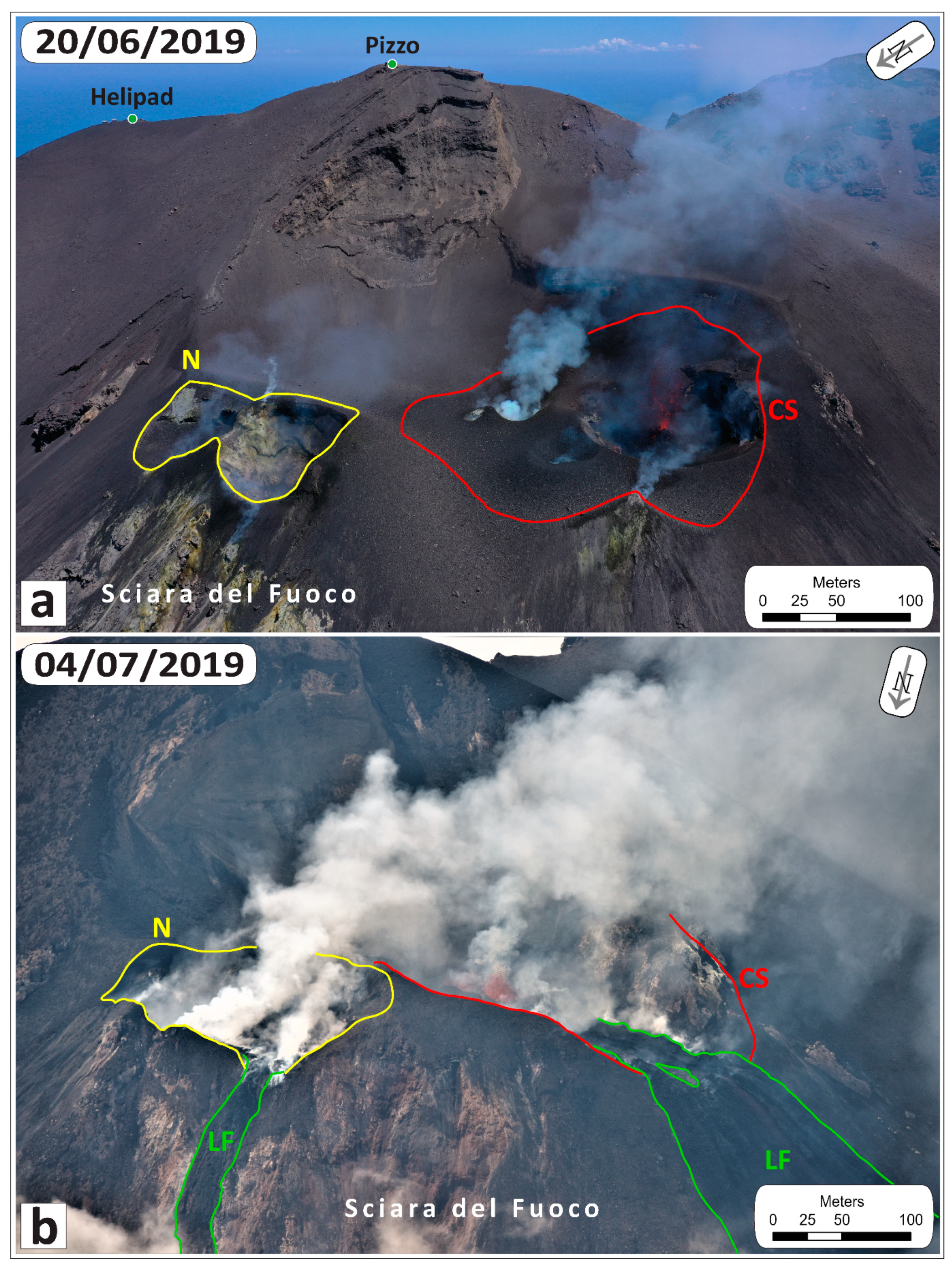

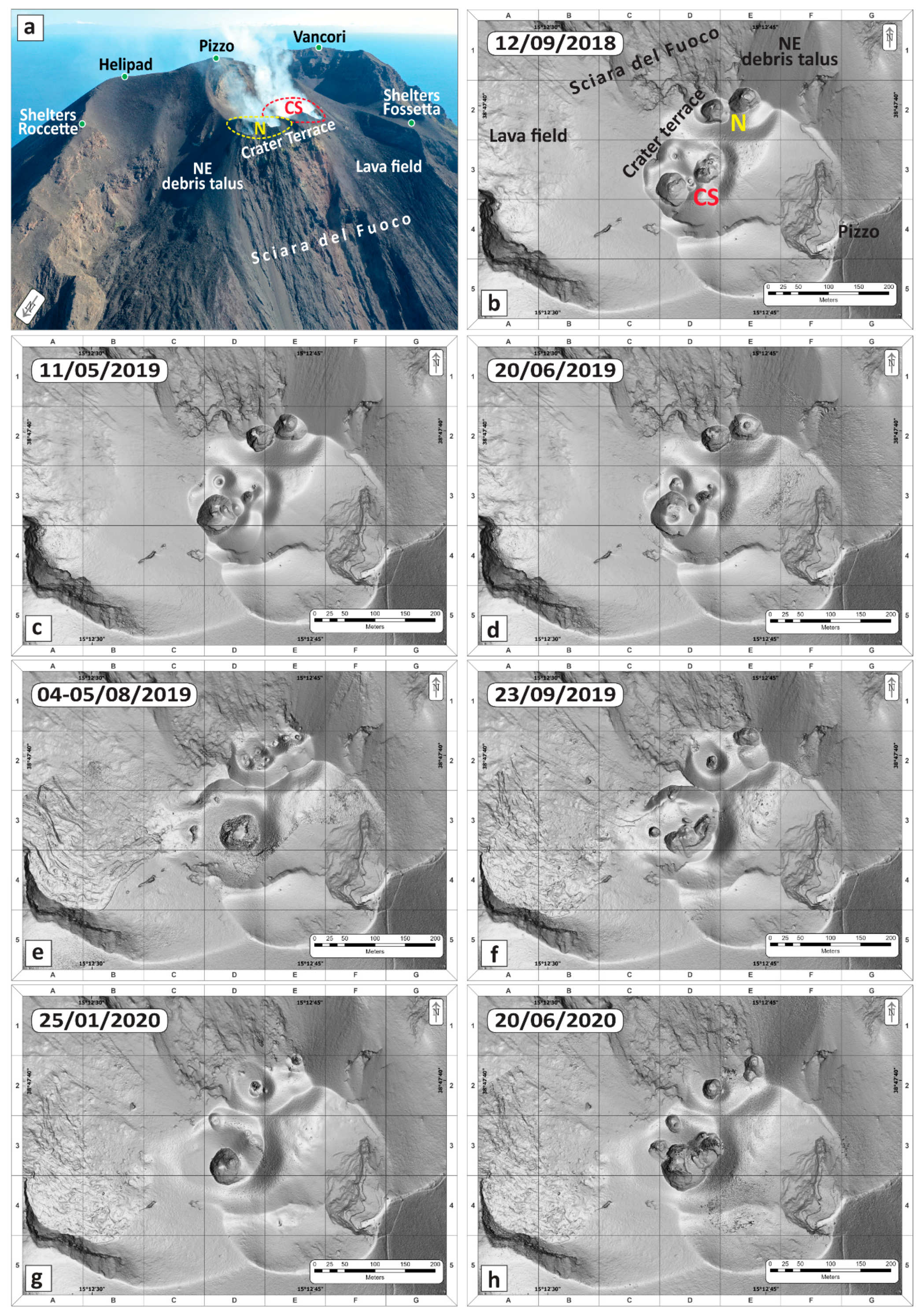


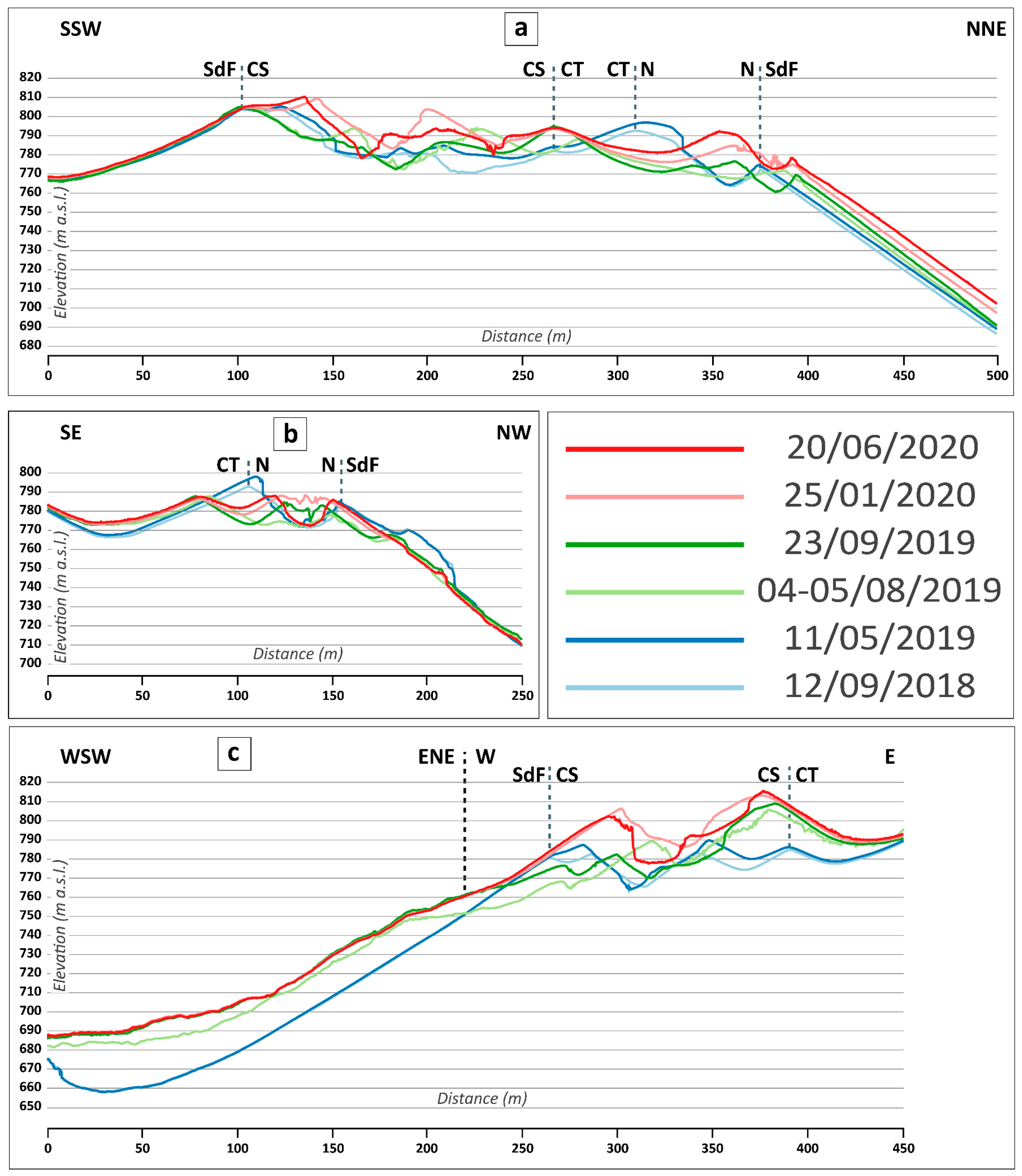

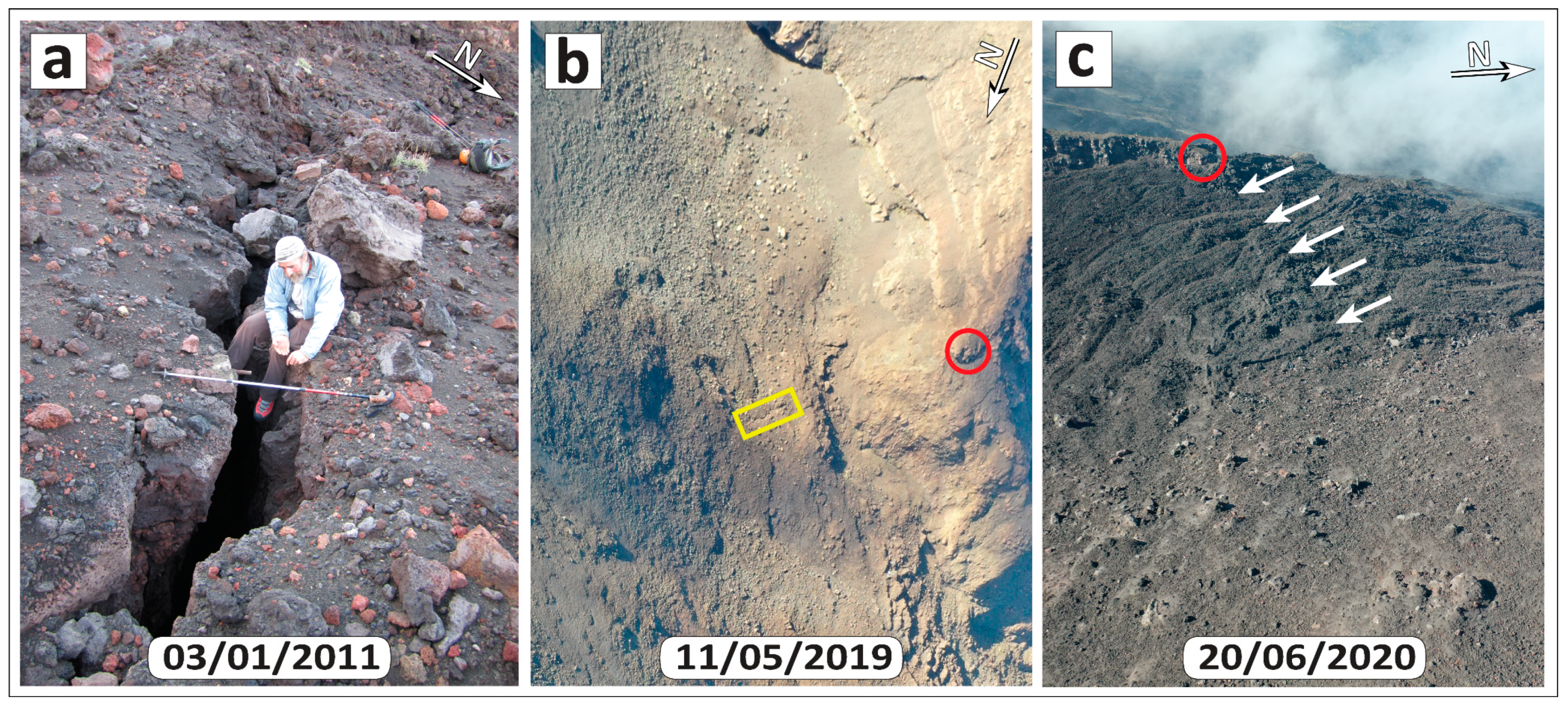
| Survey Date | 12 September 2018 * | 11 May 2019 | 20 June 2019 | 4–5 August 2019 | 23 Sebtember 2019 | 26 November 2019 (Lava Field Only) | 25 January 2020 | 20 June 2020 |
|---|---|---|---|---|---|---|---|---|
| UAS/Camera | DJI M210, Zenmuse X4S | DJI Mavic 2 Pro, L1D-20c | DJI Mavic 2 Pro, L1D-20c | DJI Mavic 2 Pro, L1D-20c | DJI Mavic 2 Pro, L1D-20c | DJI Mavic 2 Pro, L1D-20c | DJI Mavic 2 Pro, L1D-20c | DJI Mavic 2 Pro, L1D-20c |
| Weather | Clear | Clear | Clear | Clear | Clear | Cloudy | Clear | Clear |
| Flight path | Manual | Predefined | Manual | Manual | Manual | Manual | Manual | Predefined |
| # of images | 379 | 279 | 47 | 230 | 175 | 150 | 353 | 646 |
| Point density (pts/m2) | 72.9 | 156 | 143 | 81.5 | 121 | 82 | 131 | 34.9 |
| Dense cloud points | 73,083,405 | 77,568,534 | 21,873,831 | 54,126,737 | 65,780,215 | 49,330,560 | 103,116,001 | 79,998,808 |
| DSM resolution (cm/pixel) | 10.2 | 8.01 | 8.07 | 9.52 | 9.08 | 11 | 8.75 | 12.4 |
| DSM area (m2) | 604,228 | 283,218 | 82,994 | 242,273 | 229,748 | 315,752 | 412,707 | 444,710 |
Publisher’s Note: MDPI stays neutral with regard to jurisdictional claims in published maps and institutional affiliations. |
© 2021 by the authors. Licensee MDPI, Basel, Switzerland. This article is an open access article distributed under the terms and conditions of the Creative Commons Attribution (CC BY) license (https://creativecommons.org/licenses/by/4.0/).
Share and Cite
Civico, R.; Ricci, T.; Scarlato, P.; Andronico, D.; Cantarero, M.; Carr, B.B.; De Beni, E.; Del Bello, E.; Johnson, J.B.; Kueppers, U.; et al. Unoccupied Aircraft Systems (UASs) Reveal the Morphological Changes at Stromboli Volcano (Italy) before, between, and after the 3 July and 28 August 2019 Paroxysmal Eruptions. Remote Sens. 2021, 13, 2870. https://doi.org/10.3390/rs13152870
Civico R, Ricci T, Scarlato P, Andronico D, Cantarero M, Carr BB, De Beni E, Del Bello E, Johnson JB, Kueppers U, et al. Unoccupied Aircraft Systems (UASs) Reveal the Morphological Changes at Stromboli Volcano (Italy) before, between, and after the 3 July and 28 August 2019 Paroxysmal Eruptions. Remote Sensing. 2021; 13(15):2870. https://doi.org/10.3390/rs13152870
Chicago/Turabian StyleCivico, Riccardo, Tullio Ricci, Piergiorgio Scarlato, Daniele Andronico, Massimo Cantarero, Brett B. Carr, Emanuela De Beni, Elisabetta Del Bello, Jeffrey B. Johnson, Ulrich Kueppers, and et al. 2021. "Unoccupied Aircraft Systems (UASs) Reveal the Morphological Changes at Stromboli Volcano (Italy) before, between, and after the 3 July and 28 August 2019 Paroxysmal Eruptions" Remote Sensing 13, no. 15: 2870. https://doi.org/10.3390/rs13152870
APA StyleCivico, R., Ricci, T., Scarlato, P., Andronico, D., Cantarero, M., Carr, B. B., De Beni, E., Del Bello, E., Johnson, J. B., Kueppers, U., Pizzimenti, L., Schmid, M., Strehlow, K., & Taddeucci, J. (2021). Unoccupied Aircraft Systems (UASs) Reveal the Morphological Changes at Stromboli Volcano (Italy) before, between, and after the 3 July and 28 August 2019 Paroxysmal Eruptions. Remote Sensing, 13(15), 2870. https://doi.org/10.3390/rs13152870






